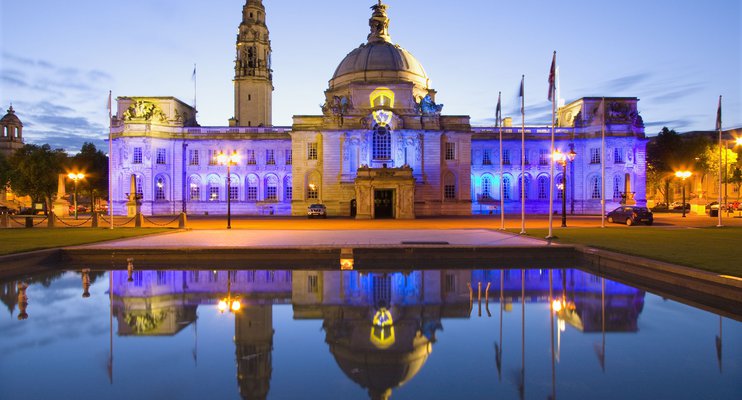BMUS are delighted to be able to bring the Annual Scientific Meeting & Technical Exhibition to another new venue for 2015 - City Hall, Cardiff. City Hall is situated in the heart of Cardiff’s elegant Civic Centre, we hope that delegates and exhibitors will enjoy the experience and agree that the building is an extremely suitable venue for Ultrasound 2015.
City Hall, Cardiff

The magnificent Edwardian City Hall is the finest building of this superb ensemble, but is actually the fifth to have served as the centre of local Government. Little is known of Cardiff’s original 'Gild Hall', but the second Town Hall stood in the middle of St Mary’s Street until it was replaced on the same site in the mid- eighteenth century. The fourth Town Hall, on the western side of St Mary's Street, was built in 1853 and remained in use until the present City Hall opened in 1904.
The Civic buildings stand in Cathays Park, once the site of a short lived Georgian mansion (1812-25), built for the 1st Marquess of Bute. The Bute family sold the 59 acres to the town in 1898, for £159,000. Plans were drawn up for the new buildings, and the new Town Hall (Cardiff was not yet a City) was to form its focal point.
The design is inspired by English and French Renaissance architecture, but has in addition all the presence and confidence of the Edwardian period, when Cardiff’s prosperity from the coal industry was at its height.
City Hall is dominated by the 194 foot high clock tower, and the dome is surmounted by a Welsh dragon, sculpted by HC Fehr. The Clock Tower of City Hall is perhaps the most distinctive architectural feature of the building, bold and asymmetrical and a well-loved Cardiff landmark.
Above the portico is the main window of the Council Chamber. This is flanked by groups of monumental statuary representing the sea receiving the City’s three rivers; the Taff, the Rhymney and the Ely. High on the west end of the façade is a group representing ‘Science and Education’ by D McGill. Other groups include ‘Music and Poetry’ and ‘Commerce and Industry’ by Paul Montford, and ‘Welsh Unity and Patriotism’ by Henry Poole.
The fountain and pool in front of the portico was added in July 1969 to commemorate the Investiture of Prince Charles as Prince of Wales. The fountain display to the west of the pool represents the Prince of Wales’ feathers; that to the east, an ornamental curtain of four jets.
The magnificent exterior of City Hall prepares the visitor for the decorative Edwardian interiors, where rooms both large and small are all elegantly proportioned. The portico leads into the main foyer and reception. Grand staircases either side, with ornate bronze balustrades, lead to the reception rooms above. On one staircase is a memorial to Captain Robert Scott and his courageous companions, who sailed from Cardiff on the Terra Nova, on their ill-fated expedition to the South Pole in 1910. On the other staircase is another bronze memorial, this time to the poet and writer Sir Edward Reed, who also served Cardiff as a Member of Parliament.
Around The City
City Hall is the focal point of the civic centre, at the very heart of the city.
The National Museum and Gallery of Wales is adjacent and many city landmarks are within a few minutes' walk, such as Cardiff Castle, the New Theatre, the Millennium Stadium, St David's Hall, the national concert hall of Wales, is close by and Cardiff International Arena is also within the city centre supporting large scale concerts and events.
The city centre offers a variety of accommodation from budget to luxurious 5-star, all within a stone's throw of City Hall.
This combination of accommodation, prestigious attractions and other activities makes City Hall an attractive and convenient venue.
For travel information please click here





